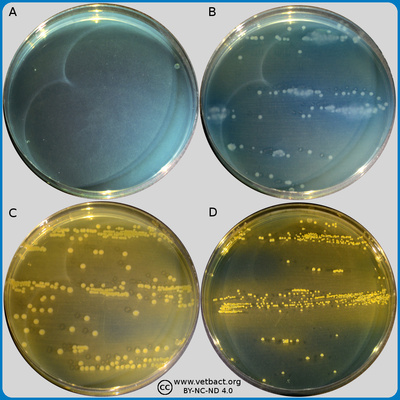Cysteine Lactose Electrolyte Deficient (CLED) agarThe figure shows CLED agar plates, where bacteria have not been cultivated on plate A. On plates B and C, Proteus vulgaris and Escherichia coli, respectively, have been cultivated. Note the colour change of plate C, where E. coli has been cultivated. Proteus spp does normally not swarm on CLED agar, but if the colonies are very close together and if the plate has been incubated for too long time, swarming may occur, which can bee seen within certain areas of plate B. Staphylococcus pseudintermedius has been cultivated on plate D. - Click on the image to enlarge it. Image: Karl-Erik Johansson (BVF, SLU) and Lise-Lotte Fernström (BVF, SLU). Applications:Cysteine Lactose Electrolyte Deficient (CLED) agar is a non-inhibitory growth medium used for isolation and differentiation of bacteria that cause urinary tract infections. Since CLED agar is electrolyte (salt) deficient, it can be used to prevent the swarming of Proteus spp. Content of the medium:
The final pH is approximately 7.3. Other comments:Lactose fermenters produce colonies that appear as yellow, whereas colonies of non-lactose fermenters appear blue on CLED agar. E. coli forms colonies, which appear as yellowish, because the agar will turn yellowish. Proteus spp. form colonies that appear as light bluish, because the agar stays blue. Klebsiella spp. form extremely mucoid colonies. These colonies may vary in colour from appearing as yellowish to light bluish and the agar will turn yellowish.
Updated: 2019-09-05. |

